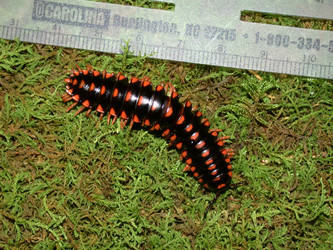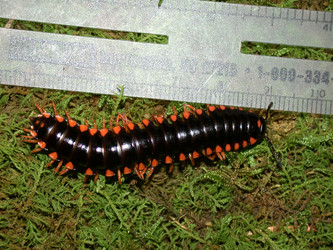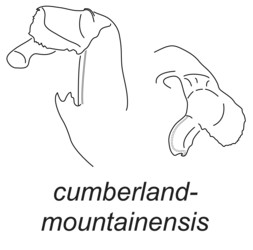Brachoria cumberlandmountainensis
The Cumberland Mountain Mimic Millipede
Paul MarekCharacteristics
Brachoria cumberlandmountainensis individuals are about 47.3 mm long and 10.5 mm wide (females 47.7 mm X 11.0 mm). Color: 3-spotted yellow (10YR 7/14, shown above) or red (8.75R 5/14); and 2-spotted red (10R 5/12).


Brachoria cumberlandmountainensis genitalia - left male gonopod acropodite (with setae removed): (Left) medial view and (Right) magnified apical view. © Paul Marek


Brachoria cumberlandmountainensis, 3-spotted red (8.75R 5/14) color morph. © Paul Marek


Brachoria cumberlandmountainensis, 2-spotted red (10R 5/12) color morph. © Paul Marek
Habitat
Brachoria cumberlandmountainensis specimens were collected during the day (14:00) in a moist forest comprising tulip, maple, and oak trees on the north-facing slope of Cumberland Mountain. Millipedes were found in a large bowl-shaped region just north of the ridge of the mountain (and through a wagonroad tunnel dynamited in the mountain for passage of wagons). Individuals were found beneath layers of decomposing leaf material under thick swathes of Urtica and Impatiens. Other xystodesmids encountered co-occurring with B. cumberlandmountainensis were Apheloria virginiensis corrugata and Gyalostethus monticolens. Note: Individuals of B. cumberlandmountainensis may be confused in the field with Apheloria virginiensis corrugata due to similarity in color patterns. Gyalostethus monticolens is easy to distinguish; it has an olive drab color and a body length about 1/2 that of B. cumberlandmountainensis.Distribution
Known only from the type locality in Harlan Co., Kentucky. The closest known Brachoria species, B. dentata, occurs about 0.7 air km NNE further down the trail amongst spectacular room-sized boulders covered with Impatiens and Urtica.Conservation status
Brachoria cumberlandmountainensis is threatened by habitat loss due to agriculture (especially growing demand for paper products), coal mining, development, and the invasion of exotic species.References
Marek P.E. 2010. A revision of the Appalachian millipede genus Brachoria Chamberlin, 1939 (Polydesmida: Xystodesmidae: Apheloriini). Zool. J. Linn. Soc. 159: 817-889.
Title Illustrations

| Scientific Name | Brachoria cumberlandmountainensis |
|---|---|
| Location | USA, Kentucky, Harlan Co. |
| Reference | Marek P.E. 2010. A revision of the Appalachian millipede genus Brachoria Chamberlin, 1939 (Polydesmida: Xystodesmidae: Apheloriini). Zool. J. Linn. Soc. 159: 817-889. |
| Specimen Condition | Live Specimen |
| Sex | m |
| Life Cycle Stage | adult |
| View | dorsal |
| Collection | USNM |
| Type | paratype |
| Collector | Paul Marek |
| Image Use |
 This media file is licensed under the Creative Commons Attribution-NonCommercial License - Version 3.0. This media file is licensed under the Creative Commons Attribution-NonCommercial License - Version 3.0.
|
| Copyright |
© Paul Marek

|
About This Page
Work on the millipede Tree of Life pages was supported by a U.S. National Science Foundation Doctoral Dissertation Improvement Grant to Paul Marek and Jason Bond (DEB 0607996) and a Partnerships for Enhancing Expertise in Taxonomy Grant to Petra Sierwald, Jason Bond, and William Shear (DEB 0529715).
Paul Marek

Virginia Polytechnic Institute and State University
Correspondence regarding this page should be directed to Paul Marek at
Page copyright © 2010 Paul Marek
 Page: Tree of Life
Brachoria cumberlandmountainensis . The Cumberland Mountain Mimic Millipede.
Authored by
Paul Marek.
The TEXT of this page is licensed under the
Creative Commons Attribution-NonCommercial License - Version 3.0. Note that images and other media
featured on this page are each governed by their own license, and they may or may not be available
for reuse. Click on an image or a media link to access the media data window, which provides the
relevant licensing information. For the general terms and conditions of ToL material reuse and
redistribution, please see the Tree of Life Copyright
Policies.
Page: Tree of Life
Brachoria cumberlandmountainensis . The Cumberland Mountain Mimic Millipede.
Authored by
Paul Marek.
The TEXT of this page is licensed under the
Creative Commons Attribution-NonCommercial License - Version 3.0. Note that images and other media
featured on this page are each governed by their own license, and they may or may not be available
for reuse. Click on an image or a media link to access the media data window, which provides the
relevant licensing information. For the general terms and conditions of ToL material reuse and
redistribution, please see the Tree of Life Copyright
Policies.
- First online 16 September 2010
- Content changed 16 September 2010
Citing this page:
Marek, Paul. 2010. Brachoria cumberlandmountainensis . The Cumberland Mountain Mimic Millipede. Version 16 September 2010 (under construction). http://tolweb.org/Brachoria_cumberlandmountainensis/144811/2010.09.16 in The Tree of Life Web Project, http://tolweb.org/







 Go to quick links
Go to quick search
Go to navigation for this section of the ToL site
Go to detailed links for the ToL site
Go to quick links
Go to quick search
Go to navigation for this section of the ToL site
Go to detailed links for the ToL site